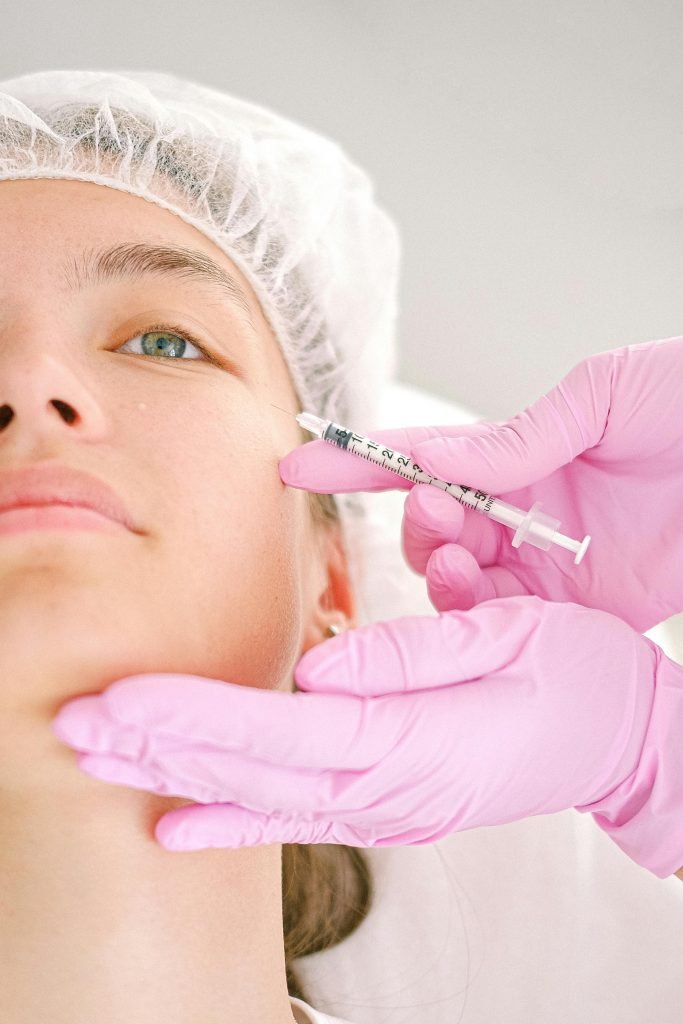BOTOX
Botulinum Toxin (Botox) is a neurotoxin produced by Clostridium botulinum, a gram-positive, anaerobic bacterium, and is one of the most potent biological substances known to humanity. It primarily works by creating a reversible blockade at the neuromuscular junction, preventing the targeted muscle from functioning. (1) Various studies have shown that Botox also inhibits the effects of other neurotransmitters such as substance P and calcitonin gene-related peptide, which mediate pain and neurogenic inflammation. (2) When Botox is used to block muscle activity, the fundamental principle of treatment is the administration of an appropriate dose to the appropriate target muscles. In this application, muscle palpation and basic anatomical techniques are used to identify the correct muscles. (3) Additionally, ensuring that the product used is an original licensed product and that the procedure is performed with the correct dose is essential for a safe application.

Botox History
The historical development of botulinum toxin is quite intriguing. In the early 19th century, the medical administration of the Kingdom of Württemberg noted an increase in food poisoning cases and issued a report on the dangers of consuming smoked sausages. Subsequently, a physician and poet named Justinus Kerner, working in a small town, described this clinical condition— which he referred to as “sausage poison”— using modern medical explanations of muscular and autonomic symptoms. Although Kerner attempted to produce this artificial toxin, he was unsuccessful. (4,5) By 1895, another case of food poisoning emerged, but this time, the culprit was not sausage but ham. Thirty-four musicians suffered botulism symptoms after consuming ham at a funeral where they had performed. Investigating the ham, Van Ermengem successfully isolated the responsible bacterium. (6) He named it Bacillus botulinum, deriving the name from the Latin word “botulus,” meaning sausage. Over the years, extensive research has been conducted on the mechanisms and structure of botulinum toxin. The first therapeutic use of botulinum toxin was by ophthalmologist Alan Scott, who sought a non-surgical treatment for strabismus. By administering botulinum toxin to strabismus patients, he pioneered its first beneficial use in humans. (7) Dr. Scott named his product “Oculinum,” which received FDA approval in 1989 for the treatment of strabismus and blepharospasm. Later, the product’s rights were sold, and its name was changed to “Botox.” This development led to its widespread medical use for strabismus and blepharospasm. The first cosmetic use of botulinum toxin was also discovered by an ophthalmologist. While treating blepharospasm, ophthalmologists Jean Carruthers and Alastair Carruthers noticed an improvement in patients’ frown lines. (8)
Botulinum toxin is produced in various forms, including Abobotulinumtoxin A, Onabotulinumtoxin A, Incobotulinumtoxin A, Prabotulinumtoxin A, and Rimabotulinumtoxin B. (As of 2025, four of these types are licensed in Turkey.) Over the years, these toxin preparations have been approved by the FDA for various indications, including strabismus, blepharospasm, glabellar lines (frown lines), forehead lines, lateral canthal lines (crow’s feet), chronic migraine, axillary hyperhidrosis (excessive underarm sweating), cervical dystonia, and spasticity. (9) Although not FDA-approved, studies suggest that botulinum toxin may also be used for bunny lines, gummy smiles, masseter hypertrophy, perioral wrinkles, chin dimpling, and sweating of the hands and feet. Research on botulinum toxin continues to expand. (10–13) Since periocular expressions are frequently and repeatedly used in daily life, wrinkles around the eyes are a significant aesthetic concern. Botox is an important option for treating these wrinkles. As each individual has unique facial movements and expressions, wrinkle patterns develop differently for everyone. (14) Due to variations in pattern and depth, Botox treatment strategies should be tailored to each patient. In addition to addressing these wrinkles, Botox can also elevate the medial eyebrow by 1 mm and the lateral eyebrow by 4.8 mm. (15)
It is important to remember that botulinum toxin is a potentially dangerous substance that can lead to severe consequences if overdosed or used incorrectly. (16-18) Recognizing complications associated with Botox applications, taking preventive measures, and ensuring appropriate interventions when complications arise are crucial for public health. The most serious complication is botulism, a severe and potentially fatal neuroparalytic disease affecting both humans and animals, caused exclusively by botulinum toxin. Symptoms of botulism typically include blurred or double vision, dry mouth, and difficulty speaking and swallowing, progressing to bilateral descending muscle weakness. (16) As the neurotoxin spreads through the body, it weakens the trunk and upper limb muscles. If left untreated, it affects respiratory muscles, leading to death due to respiratory failure. (19) Treatment for botulism includes symptomatic management, mechanical ventilation support, and intravenous administration of botulinum antitoxin. (20) Depending on the type and amount of botulinum toxin exposure, recovery can take several weeks to several months. (21) In addition to this severe complication, allergic reactions, bruising at the injection site, and headaches may occur. (22) Other complications, depending on the injection site, include eyebrow drooping, eyelid ptosis, brow asymmetry, double vision, lip asymmetry, and drooping at the corners of the mouth. These complications are reversible as they result from the toxin’s effects. (22) To prevent complications and ensure effective treatment, it is essential to adhere to medical protocols, use licensed products in medical facilities, and maintain proper storage and transportation conditions for the product.
One of the significant concerns regarding botulinum toxin is the development of immune resistance due to the body’s immune response. While the neurotoxin itself can trigger an immune response, proteins such as hemagglutinins have been identified as potential immunogenic antigens. (23) Various studies suggest that high doses, short intervals between injections, cumulative long-term dosing, needle size, injection depth, and anatomical site selection may contribute to the development of Botox resistance. (24–28) To prevent and minimize Botox resistance, it is crucial to use licensed products and apply appropriate techniques and dosages. Another important factor for Botox efficacy is proper storage conditions. Botulinum neurotoxin is a protein that can be affected by various chemical and physical conditions. Except for INCO, botulinum toxin types must be stored below 8°C, maintaining a cold chain. INCO, however, can be stored at temperatures up to 25°C. The shelf life must also be considered: 24 months for ABO and 36 months for INCO. (29) Previously, three types of Botox were licensed in Turkey, but in 2024, INCO also received approval and became available for use.
- Rawson AM, Dempster AW, Humphreys CM, Minton NP. Pathogenicity and virulence of Clostridium botulinum. Virulence. 2023 Dec 31;14(1).
- Lucioni A, Bales GT, Lotan TL, McGehee DS, Cook SP, Rapp DE. Botulinum toxin type A inhibits sensory neuropeptide release in rat bladder models of acute injury and chronic inflammation. BJU Int. 2008 Feb 3;101(3):366–70.
- Dressler D, Altavista MC, Altenmueller E, Bhidayasiri R, Bohlega S, Chana P, et al. Consensus guidelines for botulinum toxin therapy: general algorithms and dosing tables for dystonia and spasticity. J Neural Transm. 2021 Mar 26;128(3):321–35.
- Kerner J. Das Fettgift, oder die Fettsäure, und ihre Wirkungen auf den thierischen Organismus: Ein Beytrag zur Untersuchung des in verdorbenen Würsten giftig wirkenden Stoffes. Cotta; 1822.
- Erbguth FJ, Naumann M. Historical aspects of botulinum toxin. Neurology. 1999 Nov;53(8):1850–1850.
- van Ermengem E. Classics in infectious diseases. A new anaerobic bacillus and its relation to botulism. E. van Ermengem. Originally published as “Ueber einen neuen anaëroben Bacillus und seine Beziehungen zum Botulismus” in Zeitschrift für Hygiene und Infektionskrankheiten 26: 1-56, 1897. Rev Infect Dis. 1979;1(4):701–19.
- Scott AB. Botulinum Toxin Injection into Extraocular Muscles as an Alternative to Strabismus Surgery. Ophthalmology. 1980 Oct;87(10):1044–9.
- Carruthers JDA, Carruthers JA. Treatment of Glabellar Frown Lines with C. Botulinum‐A Exotoxin. J Dermatol Surg Oncol. 1992 Jan 20;18(1):17–21.
- Whitcup SM. The History of Botulinum Toxins in Medicine: A Thousand Year Journey. In 2019. p. 3–10.
- Kim HJ, Seo KK, Lee HK, Kim J. Clinical anatomy of the face for filler and botulinum toxin injection. Turk Dermatoloji Dergisi. Springer; 2016.
- Kim HJ, Youn KH, Kim JS, Kim YS, Hong SO, Na J. US Anatomy of the midface and nose. Ultrasonographic Anatomy of the Face and Neck for Minimally Invasive Procedures: An Anatomic Guideline for Ultrasonographic-Guided Procedures. Singapore: Springer Singapore; 2021.
- Hong SO. Cosmetic Treatment Using Botulinum Toxin in the Oral and Maxillofacial Area: A Narrative Review of Esthetic Techniques. Toxins (Basel). 2023 Jan 17;15(2):82.
- SCHNIDER P, BINDER M, AUFF E, KITTLER H, BERGER T, WOLFF K. Double-blind trial of botulinum A toxin for the treatment of focal hyperhidrosis of the palms. British Journal of Dermatology. 1997 Apr;136(4):548–52.
- Kane MAC. Classification of Crow’s Feet Patterns among Caucasian Women: The Key to Individualizing Treatment. Plast Reconstr Surg. 2003 Oct;112(Supplement):33S-39S.
- Ahn MS, Catten M, Maas CS. Temporal Brow Lift Using Botulinum Toxin A. Plast Reconstr Surg. 2000 Mar;105(3):1129–35.
- Sobel J. Botulism. Clinical Infectious Diseases. 2005 Oct 15;41(8):1167–73.
- Peck MW. Clostridium botulinum and the safety of minimally heated, chilled foods: an emerging issue? J Appl Microbiol. 2006 Sep;101(3):556–70.
- Arnon SS, Rood JI, McClane BA. Human tetanus and human botulism. The clostridia: molecular biology and pathogenesis. 1997;
- Johnson EA, Montecucco C. Botulism. In 2008. p. 333–68.
- O’Horo JC, Harper EP, El Rafei A, Ali R, DeSimone DC, Sakusic A, et al. Efficacy of Antitoxin Therapy in Treating Patients With Foodborne Botulism: A Systematic Review and Meta-analysis of Cases, 1923–2016. Clinical Infectious Diseases. 2018 Jan 1;66(suppl_1):S43–56.
- Rao AK, Sobel J, Chatham-Stephens K, Luquez C. Clinical Guidelines for Diagnosis and Treatment of Botulism, 2021. MMWR Recommendations and Reports. 2021 May 7;70(2):1–30.
- Sethi N, Singh S, DeBoulle K, Rahman E. A Review of Complications Due to the Use of Botulinum Toxin A for Cosmetic Indications. Aesthetic Plast Surg. 2021 Jun 13;45(3):1210–20.
- Pratt KP. Engineering less immunogenic and antigenic FVIII proteins. Cell Immunol. 2016 Mar;301:12–7.
- Benecke R. Clinical Relevance of Botulinum Toxin Immunogenicity. BioDrugs. 2012 Apr;26(2):e1–9.
- Schulte‐Baukloh H, Bigalke H, Miller K, Heine G, Pape D, Lehmann J, et al. Botulinum neurotoxin type A in urology: Antibodies as a cause of therapy failure. International Journal of Urology. 2008 May 29;15(5):407–15.
- Rahman E, Carruthers JDA. Immunogenicity of Botulinum Toxin A: Insights. Dermatologic Surgery. 2024 Sep;50(9S):S117–26.
- Rahman E, Alhitmi HK, Mosahebi A. Immunogenicity to Botulinum Toxin Type A: A Systematic Review With Meta-Analysis Across Therapeutic Indications. Aesthet Surg J. 2022 Jan 1;42(1):106–20.
- Fabbri M, Leodori G, Fernandes RM, Bhidayasiri R, Marti MJ, Colosimo C, et al. Neutralizing Antibody and Botulinum Toxin Therapy: A Systematic Review and Meta-analysis. Neurotox Res. 2016 Jan 14;29(1):105–17.
- Dressler D, Bigalke H. Long-term stability of reconstituted incobotulinumtoxinA: how can we reduce costs of botulinum toxin therapy? J Neural Transm. 2017 Oct 2;124(10):1223–5. (Tekirdag Botox)


